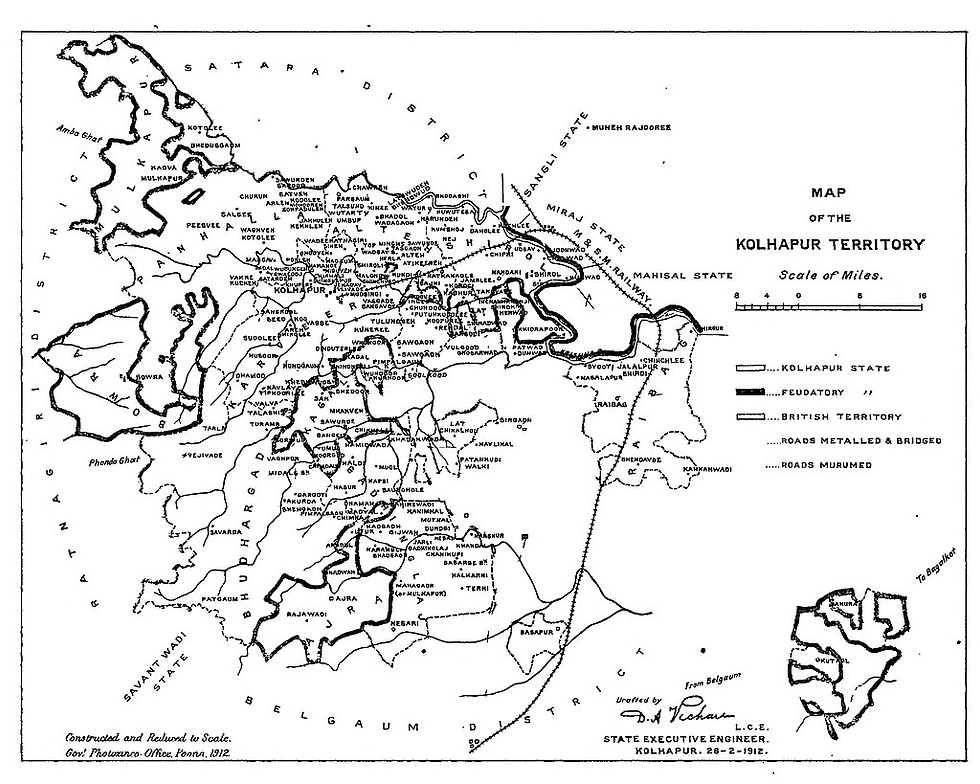12 | Kolhapur State
- indiastatestories
- Sep 1
- 2 min read
Updated: Oct 29
Made with NotebookLM
Kolhapur was one of the most significant princely states in the Deccan, with an area of 3,219 square miles, a population of nearly 1.1 million, and annual revenue of about Rs. 12.8 million (Menon, 1957, p. 276). Its rulers carried the prestigious title of Chhatrapati Maharaj, tracing lineage to Tarabai, the wife of Rajaram, son of Chhatrapati Shivaji. The renowned Chhatrapati Shahu Maharaj (1874–1922) was admired for his progressive governance—he introduced reservations for Dalits, supported Dr. B.R. Ambedkar’s education, and backed the anti-caste movement in the Bombay Presidency (Menon, 1957).

Initially, Kolhapur was excluded from the 1948 merger of the Deccan states due to concerns that premature action could alienate the Maratha community, who viewed the Kolhapur ruler as their spiritual head (Menon, 1957).

Key Factors Impacting Merger
Succession Dispute: After the death of Maharaja Rajaram Chhatrapati in 1940 without a male heir, a six-week-old was nominated but soon passed away. Vikramasinha Rao, Maharajah of Dewas Senior, was then adopted as Shahaji Chhatrapati II in 1947. This adoption faced public resistance and a legal petition, prompting the ruler to expedite merger talks. The Government of India, however, upheld pre-independence succession decisions to avoid administrative chaos.
Law and Order Breakdown: After Gandhi’s assassination in January 1948, riots broke out in Kolhapur. Maratha factions launched violent attacks on Brahmin and Bania communities, prompting the Maharajah to accept a Government of India-appointed administrator.
Financial Instability: A central inquiry revealed financial weakness, leading the Indian Government to extend a loan to Kolhapur.
Plebiscite Rejected: Though there were calls for a plebiscite, the States Ministry dismissed it, fearing communal divisions. The merger could only proceed with the Maharajah’s free and willing consent.
Privy Purse Negotiations: After cordial discussions in Delhi, the Privy Purse for Kolhapur was set at Rs. 10 lakh annually, using the Eastern States Formula. Despite this, Kolhapur received a relatively higher allowance than most other states. The case was referred to the Indian States Finances Enquiry Committee due to ongoing financial issues.
Merger Finalization

In February 1949, Shahaji Chhatrapati II signed the Merger Agreement. The Government of Bombay officially took over Kolhapur’s administration on 1 March 1949, at a ceremony led by B. G. Kher, then Premier of Bombay. V. P. Menon, representing the central government, formally transferred control (White Paper, 1950).
The Merger Agreement affirmed that the Maharajah ceded ‘full and exclusive authority, jurisdiction, and powers’ related to governance to the Dominion of India, citing the best interest of both Kolhapur and the Union (White Paper, 1950). The territory of Kolhapur later became modern-day Kolhapur district in Maharashtra.

References:
Menon, V. P. (1957). The Transfer of Power in India (Reprinted). Orient Longman.
Ministry of States. (1950). White Paper on Indian States. Government of India. https://en.wikisource.org/wiki/White_Paper_on_Indian_States_(1950)




Comments